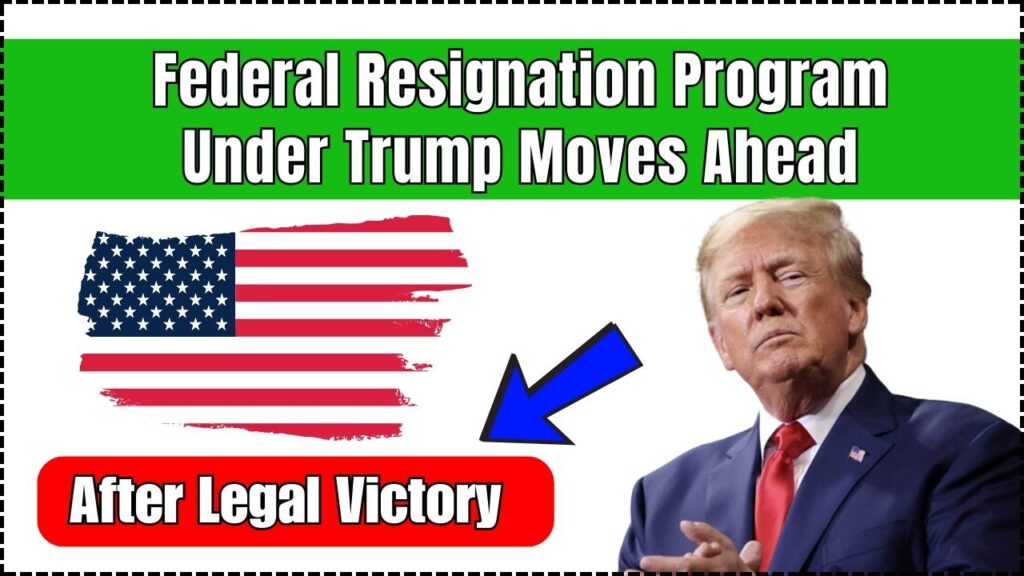
Federal Resignation Program Under Trump Moves: The Federal Resignation Program under former President Donald Trump has officially moved forward after a legal victory in federal court. This program, designed to reduce the size of the federal workforce, allows government employees to resign voluntarily while receiving financial incentives. With over 75,000 federal workers already opting in, the initiative has sparked intense debate over its implications.
Federal Resignation Program Under Trump Moves
| Aspect | Details |
|---|---|
| Program Name | Federal Resignation Program |
| Objective | Reduce the federal workforce through voluntary resignations |
| Legal Status | Approved by U.S. District Judge George O’Toole Jr. |
| Current Participation | Over 75,000 employees have accepted offers |
| Incentives | Continued salary and benefits until September 30, 2025 |
| Union Opposition | Unions claim the program is coercive and illegal |
| Administrative Lead | Office of Personnel Management (OPM) |
| Further Legal Action | Unions considering additional lawsuits |
| More Info | AP News |
The Federal Resignation Program under the Trump administration is now moving forward after a key legal victory. While the initiative aims to streamline government functions, it remains a contentious issue due to concerns over job security and public service effectiveness. With over 75,000 federal employees opting in, this policy could reshape the future of the U.S. government workforce.
What is the Federal Resignation Program?
The Federal Resignation Program, initiated during the Trump administration, is a government workforce reduction strategy. Employees who choose to resign are eligible for a financial package, which includes continued salary and benefits for a predetermined period.
The Department of Government Efficiency (DOGE), led by Elon Musk, has been at the forefront of implementing this initiative. According to official statements, the program aims to streamline government functions and reduce costs associated with maintaining a large federal workforce.
Why is the Program Controversial?
While the Trump administration has framed this initiative as an opportunity for federal workers to transition smoothly out of government roles, unions and employee advocacy groups argue that it is a disguised effort to dismantle the federal workforce.
Arguments in Favor of the Program
- Cost Reduction: By decreasing the workforce, the government saves billions in salaries and pensions.
- Efficiency Focus: A smaller workforce allows for leaner, more agile governance.
- Voluntary Participation: Employees choose whether to participate, rather than being forced out.
Criticism & Legal Challenges
- Union Pushback: Labor unions argue that employees are being pressured into resigning.
- Job Security Concerns: Diminishing the federal workforce could lead to service disruptions.
- Future Legal Action: Unions are considering appealing the court’s decision to challenge the program’s legality.
Who is Affected by the Program?
The program primarily targets mid-to-senior level employees across various federal agencies. It has no direct impact on military personnel or essential workers in critical departments such as Homeland Security or Veterans Affairs.
Eligible employees include:
- Civil servants with at least 10 years of service.
- Non-essential staff in administrative and clerical roles.
- Employees close to retirement age who may prefer financial incentives over continued employment.
How Does the Program Work?
- Eligible employees receive an official resignation offer.
- Those who accept continue to receive their salary and benefits until September 30, 2025.
- Departments adjust staffing levels accordingly to maintain operational efficiency.
- New hiring is frozen in affected departments until further notice.
- Employees seeking re-employment in the federal system face a two-year waiting period before reapplying.
Social Security Confirms $1,580 SSDI Payments – Check Exact Payment Date and Eligibility Criteria
Social Security Increase – How To Check If You Are Eligible For it? Check Here
How To Get $4,018 From Social Security On February 12-26, 2025: Check Eligibility Criteria
Implications for the Federal Workforce
Experts believe the long-term impact of the program could include:
- A significant reduction in overall government employment.
- Increased privatization of previously public-sector roles.
- A shift in federal hiring practices to focus on temporary and contract-based employment rather than full-time civil service positions.
While supporters argue that this restructuring is necessary for modern governance, critics fear it could erode the stability of public-sector jobs and services.
FAQs
1. What benefits do employees receive under this program?
Employees who voluntarily resign will receive their full salary and benefits until September 30, 2025.
2. Can employees reapply for federal jobs later?
Yes, but there is a two-year waiting period before former employees can reapply for positions in the federal system.
3. Why are unions opposing the program?
Unions claim the program coerces employees into leaving and reduces job security for public servants.
4. Will this program affect government services?
It may lead to temporary service disruptions, particularly in agencies that experience high resignation rates.
5. What happens if I refuse the resignation offer?
Employees can choose to remain in their roles, but future workforce reductions could impact job security.








